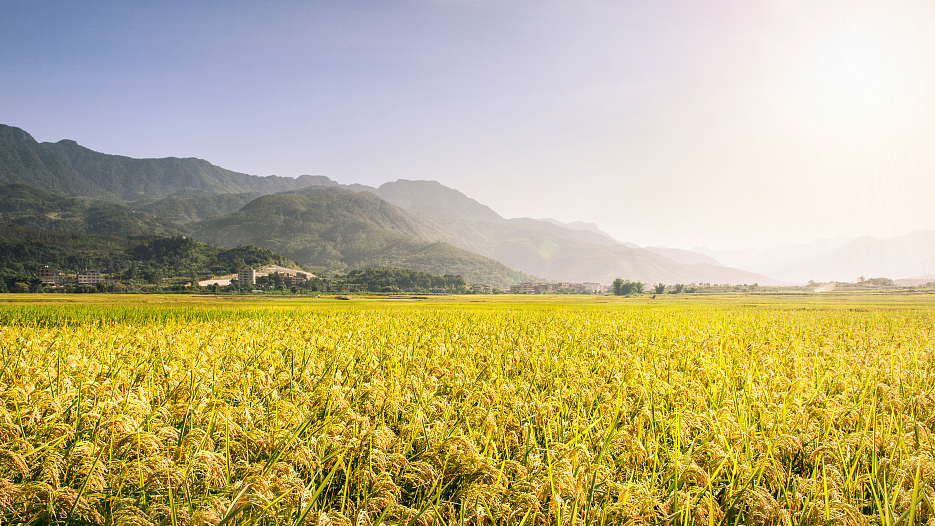
In the face of the epidemic, the ups and downs of the international agricultural market and a series of droughts, China's grain harvest has not come easily. /CFP
In the face of the epidemic, the ups and downs of the international agricultural market and a series of droughts, China's grain harvest has not come easily. /CFP
Editor's Note: Li Chunding is a director and professor for the Economics and Trade Department of the School of Economics and Management, China Agricultural University, and Zheng Fei is a research assistant for the Institute of International Economics, School of Economics and Management, China Agricultural University. The article reflects the authors' opinion, and not necessarily the views of CGTN.
This year, China has achieved a bumper harvest in summer and autumn grain crops, and early rice. The output of summer grain and early rice increased by 1.435 million tons and 105 thousand tons respectively. The main areas of autumn grain production, especially in Northeast China, Huang-Huai-Hai and Northwest China grew better than last year. In the face of the epidemic, the ups and downs of the international agricultural market and a series of droughts, China's grain harvest has not come easily, and it has effectively ensured food security.
China's Ministry of Agriculture and Rural Affairs said that this year's autumn grain area exceeded 86.7 million hectares, and most of the autumn grain growth was good, especially corn. Corn accounted for more than half of the autumn grain output and was generally better than last year. Autumn grain is the main part of China's annual production, accounting for 75% of annual output. By Sept. 20, China had harvested 15.7 million hectares of autumn grain, 18.1 percent of the total and 0.9 percent faster than last year. By region, more than half of the crops have been harvested in the southwest, the middle and lower reaches of the Yangtze River and southern China accounted for about 20 percent of the autumn grain harvest, the northwest for about 15 percent, while it was sporadic in the Huang-Huai-Hai and northeastern regions. The National Food and Strategic Reserves Administration has made a scheduling analysis of the autumn grain purchase situation and is expected to buy about 185 million tons in the peak season.
Influenced by various adverse factors such as repeated outbreaks of the new Covid-19 epidemic and "dry up in flood season" in the Yangtze River basin, domestic grain production and supply have experienced a difficult challenge this year. However, with the promotion of a series of national and local agricultural support policies, the agricultural disaster prevention and mitigation capacity has been continuously improved while the rate of agricultural natural disasters has been reduced. In addition, all parts of the country improved the quality of land preparation, increased the amount of sowing and raised the application of base fertilizer to reduce the impact of late sowing. This year, China's total output of summer grain was 147.39 million tons, an increase of 1.43 million tons over the previous year, up 1% year on year; The yield of summer grain per hectare reached 5.56 tons, an increase of 34.5 kg over the previous year. The summer grain production was not only increased, but also the wheat quality was significantly better than that of the previous year.
Looking forward to the overall grain harvest in the whole year, China's grain production will continue to be stable and high, and grain output will rise to a high level. The annual grain output is expected to remain above 650 million tons, and the per capita grain output will continue to be stable above 450 kg. The production of cotton, oil, and vegetables and the supply of livestock products and aquatic products will be stable, and the grain inventory will be sufficient.
Due to the epidemic, the disaster situation and the geopolitical influence of the Russian-Ukrainian conflict, the problem of world food security this year is extremely serious. The state of food security and nutrition in the world 2022 shows that the world is deviating from the goal of eliminating hunger and malnutrition. The number of people affected by hunger in the world was expected to total 228 million in 2021, an increase of 46 million over the same period last year. The number of hungry people in 2022 was also expected to increase. In the face of the adverse global food security outlook, China's bumper grain harvest will not only ensure domestic food security, but also provide a stable guarantee for world food security.
As the world's second largest economy and a major food producer and consumer, China's domestic food security plays an important role in global food security. A good harvest means that China's grain production and stock are sufficient to meet domestic consumption demand. That will also help safeguard world food security. In terms of food trade liberalization and governance, China advocates open trade in agricultural products and is gradually building a new pattern of agricultural opening-up. China is committed to promoting multilateral governance of food supply and trade, thus contributing to global food security. Of course, in the face of volatile international prices and risks to global food security, China needs to further assume its responsibility as a major country, ensure food supply and production, and stabilize the global food supply chain. We will more actively promote global food governance and international cooperation to safeguard global food security.